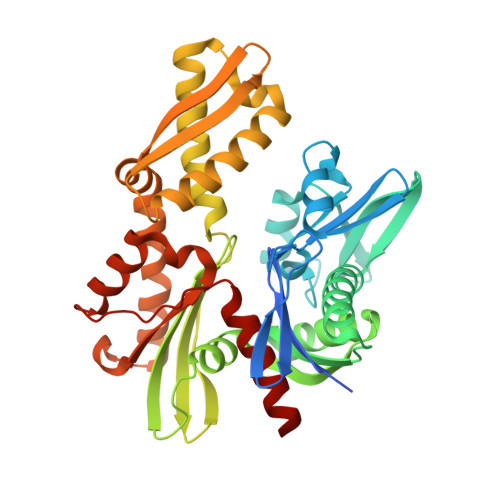A non-traditional crystal-based compound screening method targeting the ATP binding site of Plasmodium falciparum GRP78 for identification of novel nucleoside analogues.
Mrozek, A., Antoshchenko, T., Chen, Y., Zepeda-Velazquez, C., Smil, D., Kumar, N., Lu, H., Park, H.W.(2022) Front Mol Biosci 9: 956095-956095
- PubMed: 36275624
- DOI: https://doi.org/10.3389/fmolb.2022.956095
- Primary Citation of Related Structures:
8D1P, 8D1Q, 8D1S, 8D1Y, 8D20, 8D22, 8D24 - PubMed Abstract:
Drug resistance to front-line malarial treatments represents an ongoing threat to control malaria, a vector borne infectious disease. The malarial parasite, Plasmodium falciparum has developed genetic variants, conferring resistance to the current standard therapeutic artemisinin and its derivatives commonly referred to as artemisinin-combination therapies (ACTs). Emergence of multi-drug resistance parasite genotypes is a warning of potential treatment failure, reaffirming the urgent and critical need to find and validate alternate drug targets to prevent the spread of disease. An attractive and novel drug target includes glucose-regulated protein 78 kDa (GRP78, or BiP), an essential molecular chaperone protein involved in the unfolded protein response that is upregulated in ACT treated P. falciparum parasites. We have shown that both sequence and structure are closely related to human GRP78 (hGRP78), a chaperone belonging to the HSP70 class of ATPase proteins, which is often upregulated in cellular stress responses and cancer. By screening a library of nucleoside analogues, we identified eight 'hit' compounds binding at the active site of the ATP binding domain of P. falciparum GRP78 using a high-throughput ligand soaking screen using x-ray crystallography. These compounds were further evaluated using protein thermal shift assays to assess target binding activity. The nucleoside analogues identified from our screen provide a starting point for the development of more potent and selective antimalarial inhibitors. In addition, we have established a well-defined, high-throughput crystal-based screening approach that can be applied to many crystallizable P. falciparum proteins for generating anti- Plasmodium specific compounds.
Organizational Affiliation:
Department of Biochemistry & Molecular Biology, Tulane University School of Medicine, New Orleans, LA, United States.
















